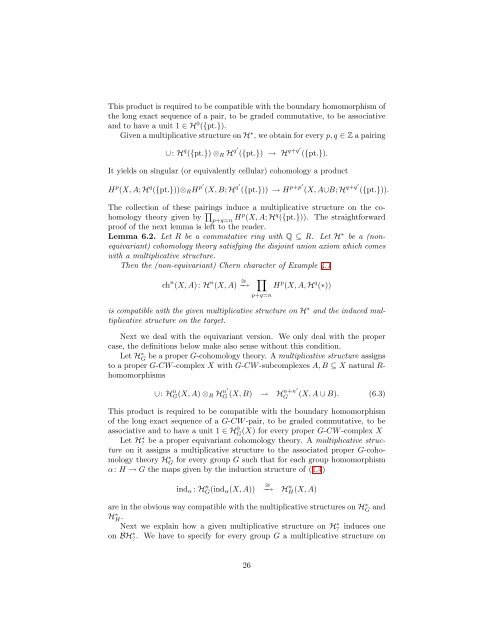Equivariant Cohomological Chern Characters
Equivariant Cohomological Chern Characters
Equivariant Cohomological Chern Characters
You also want an ePaper? Increase the reach of your titles
YUMPU automatically turns print PDFs into web optimized ePapers that Google loves.
This product is required to be compatible with the boundary homomorphism ofthe long exact sequence of a pair, to be graded commutative, to be associativeand to have a unit 1 ∈ H 0 ({pt.}).Given a multiplicative structure on H ∗ , we obtain for every p, q ∈ Z a pairing∪: H q ({pt.}) ⊗ R H q′ ({pt.}) → H q+q′ ({pt.}).It yields on singular (or equivalently cellular) cohomology a productH p (X, A; H q ({pt.}))⊗ R H p′ (X, B; H q′ ({pt.})) → H p+p′ (X, A∪B; H q+q′ ({pt.})).The collection of these pairings induce a multiplicative structure on the cohomologytheory given by ∏ p+q=n Hp (X, A; H q ({pt.})). The straightforwardproof of the next lemma is left to the reader.Lemma 6.2. Let R be a commutative ring with Q ⊆ R. Let H ∗ be a (nonequivariant)cohomology theory satisfying the disjoint union axiom which comeswith a multiplicative structure.Then the (non-equivariant) <strong>Chern</strong> character of Example 4.1ch n (X, A): H n (X, A) ∼= −→∏p+q=nH p (X, A, H q (∗))is compatible with the given multiplicative structure on H ∗ and the induced multiplicativestructure on the target.Next we deal with the equivariant version. We only deal with the propercase, the definitions below make also sense without this condition.Let HG ∗ be a proper G-cohomology theory. A multiplicative structure assignsto a proper G-CW -complex X with G-CW -subcomplexes A, B ⊆ X natural R-homomorphisms∪: H n G(X, A) ⊗ R H n′G (X, B) → H n+n′G(X, A ∪ B). (6.3)This product is required to be compatible with the boundary homomorphismof the long exact sequence of a G-CW -pair, to be graded commutative, to beassociative and to have a unit 1 ∈ HG 0 (X) for every proper G-CW -complex XLet H? ∗ be a proper equivariant cohomology theory. A multiplicative structureon it assigns a multiplicative structure to the associated proper G-cohomologytheory HG ∗ for every group G such that for each group homomorphismα: H → G the maps given by the induction structure of (1.4)ind α : H n G(ind α (X, A))∼ =−→ H n H(X, A)are in the obvious way compatible with the multiplicative structures on HG ∗ andHH ∗ Ṅext we explain how a given multiplicative structure on H ?∗ induces oneon BH? ∗ . We have to specify for every group G a multiplicative structure on26
















